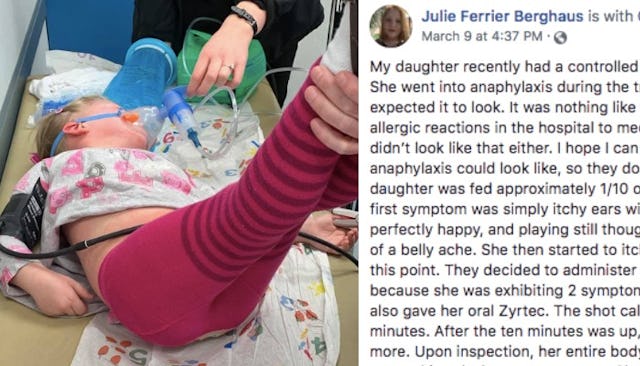This Mom Wants You To Know What Anaphylactic Shock REALLY Looks Like

After her daughter had a severe reaction to a nut allergy test, this mom posted about the signs other parents should look for
Julie Ferrier Berghaus recently had her daughter tested for a cashew allergy at the doctor’s office – and when her toddler went into anaphylactic shock, she learned a lot about what the medical emergency does and doesn’t look like.
After going through the ordeal, she took to Facebook to share what she’d learned, both about what severe allergic reactions look like and about what you should do if someone starts to have a reaction when you’re around.
First and foremost, Berghaus wanted everyone to know that much like heart attacks and strokes, anaphylactic shock doesn’t look like how it’s depicted in Hollywood – the signs are both different and more subtle.
“It looked nothing like I expected it to look,” she wrote. “It was nothing like they show on TV. I’ve seen allergic reactions in the hospital to medications as well, anaphylaxis didn’t look like that either. I hope I can educate some people on what anaphylaxis could look like, so they don’t wait to give epi.”
In the first ten minutes or so, her daughter initially started to feel itchy, and then complained of a tummy ache. At that point, she was given epinephrine (an EpiPen) and oral Zyrtec, but the symptoms kept coming. She broke out in full-body hives – and the itching got worse.
During this whole time, she was playing and acting normally. Her body and vital signs, though, were telling a different story.
“We couldn’t hear her breathing hard or wheezing at all. We called the nurse just to double check, and she listened with her stethoscope,” the mom wrote. “She said she was wheezing and tight. When her vitals were taken, her sats were in the low 80’s, her bp was low, and her pulse was high. Amazingly, she was still just playing, and just annoyed with the itchy hives!”
Suddenly, their daughter turned for the worse, despite the ongoing medications, and blacked out. She was given several more medications, and needed to be observed for hours. All for one-tenth of a cashew.
“I just want others to make sure the people in their children’s lives understand how serious these allergies are,” she told Scary Mommy. “I also don’t want them to be scared to give epi. For some reason people hesitate and wait, like epi is some big deal, it’s not! It’s lifesaving and so important!”
The second half of the post focused on EpiPen information, most importantly, that using an Epi won’t hurt her even if she’s not having a serious reaction.
“Please if you are one of the people that cares for my child or spends time with her, be careful what you eat around her, what you give her, and DON’T be afraid to give epi,” she wrote. “She had zero side effects from the epi. It could save her life. Much rather safe than sorry. There is NO danger in giving the epi to her even if she ended up not in a true reaction, she has no underlying heart disease or anything. Epi will NOT harm her, even if it wasn’t needed. You want to react before she gets this severe! It’s a matter of life and death for her.”
Another tip? Call 911 even if the first EpiPen does its job: these reactions can have second waves and your child needs to be under observation just in case.
Finally, don’t worry if an epi is slightly out of date: they can still save a life while waiting for paramedics.
Commenters thanked Berghaus for her viral post, some sharing their own stories about severe food allergies and anaphylactic shock, specifically severe reactions to tree nut allergies. One shared a story of her 12-year-old breathing peanut dust at a steakhouse – his first sign was simply an itchy, burning throat. Another had a similar story about the subtle signs of a nut allergy reaction:
“My son is allergic to cashews as well and it’s the only allergy in our family,” she wrote. “When he had his first and only reaction it was nothing like what I expected it to be. He was 2 and initial oral mouth pain which was the only real symptom for a good 20 minutes. Then over the next 20 his whole body became covered in hives and his face started to swell and water was pouring out of his eye and nose and his breathing became labored last of all. It was nothing like I’ve seen or heard about before and I was so unsure if he needed medical attention until the more serious symptoms began.”
Another also had her life saved by an expired EpiPen after she went into anaphylactic shock:
“I ate out at restaurant and 30 min later I went into anaphylactic shock,” the commenter wrote. “The epi pen I had was expired but was administered anyways. Had it not been used I would have died before emt’s arrived. They told my husband that he saved my life by giving it to me.”
An estimated 32 million Americans have food allergies, and an allergic reaction to food sends someone to the emergency room once every three minutes in the United States. About 200 people die each year from severe food allergies, and the vast majority could have been saved by a timely EpiPen injection.
This article was originally published on